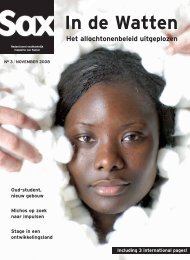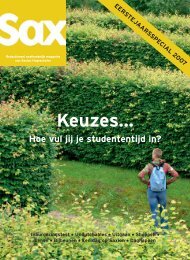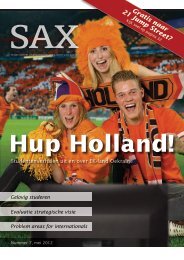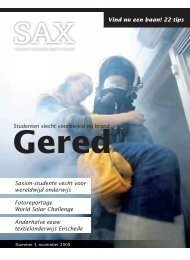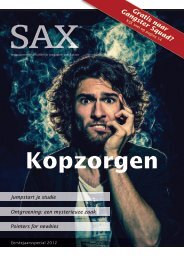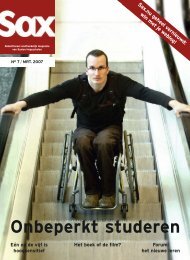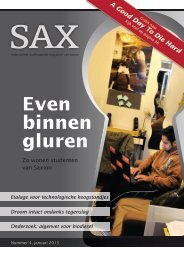Studiestrijd - Sax.nu
Studiestrijd - Sax.nu
Studiestrijd - Sax.nu
Create successful ePaper yourself
Turn your PDF publications into a flip-book with our unique Google optimized e-Paper software.
International<br />
Internationals<br />
Keep on<br />
coming<br />
The <strong>nu</strong>mber of international students studying at<br />
<strong>Sax</strong>ion is still on the rise. This academic year 671<br />
international students are enrolled at <strong>Sax</strong>ion.<br />
Last year <strong>Sax</strong>ion attracted 280 new students.<br />
Chris van den Borne, manager of the International Office, says: ”Part of<br />
the increase can be explained by the fact that the <strong>nu</strong>mber of Norwegian<br />
students studying Physiotherapy at <strong>Sax</strong>ion is now included in the<br />
total <strong>nu</strong>mber of international students registered at the International<br />
Office. Even without including them though the total increase is still<br />
enormous: 550 in total.”<br />
Van den Borne does not have an explanation for the rest of the increase.<br />
“<strong>Sax</strong>ion is still very popular among particularly Asian students,<br />
but we try to attract students from all over the world. Every year we<br />
start different projects with different countries and there are new policies,<br />
scholarships and programs that allow students to study abroad.<br />
This year, for instance, we have a student from Oman, because of a<br />
new government scholarship program. It changes from time to time.”<br />
Although the amount of students keeps increasing, the variety in nationalities<br />
does not. This year there are approximately sixty different<br />
nationalities. The amount of nationalities does not vary much each<br />
year, says Van den Borne. “One year there are 58, the next year there<br />
are 54. Most international Institutes have about the same <strong>nu</strong>mber of<br />
different nationalities as <strong>Sax</strong>ion. (WvT)<br />
Dutch Pea Soup<br />
As soon as the leaves start falling from the trees the Dutch get<br />
a craving for erwtensoep, also known as snert. To the untrained<br />
eye, it looks anything but tasteful, but you have to try this typical<br />
Dutch dish at least once while you’re here.<br />
The recipe finds its origin in the time when winters in Holland were still<br />
very cold. Here’s the traditional recipe. You can leave out the pork hock if<br />
this is too much trouble. When ready you should be able to put a spoon<br />
into it and not have it fall down again.<br />
Ingredients for 8-10 serves:<br />
1 lb. split peas<br />
10 cups of water<br />
1 pork hock (part of leg)<br />
1 to 2 bay leaves<br />
2 leeks, cut in pieces<br />
2 celery hearts, cut in pieces<br />
1 potato, peeled and diced<br />
12 oz. bratwurst or smoked sausage<br />
1 cup of celery leaves<br />
1 onion, cut in pieces<br />
salt and pepper to taste<br />
Wash and rinse the split peas and put them in a pot with the water. Add<br />
the pork hock, the bay leaves, the onion, and the salt to the pot. Cook this<br />
for about an hour and a half, while stirring from time to time. Add the cut<br />
vegetables and cook for another 30 mi<strong>nu</strong>tes. Add the whole sausage at<br />
this point as well. Now take out the meat, remove the skin and dice the<br />
meat into small pieces and add back to the soup. Cut the sausage into<br />
slices and add back to the soup. Or you buy it in a can in the supermarket<br />
(make sure it’s Unox). (MvdM)<br />
Foto: Toma Tudor<br />
International students more ambitious<br />
Bernadette Wijers teaches English at IBMS which stands for International Business and Management Studies.<br />
This 4-year course is part of the School of Marketing and International Management (MIM). IBMS Students<br />
come from all over the world and the curriculum is taught in English.<br />
Wijers: “We have a lot of German and a few Dutch<br />
students. The rest are from different countries<br />
like Russia, China, France and Vietnam. I started<br />
teaching international students in 1990. My<br />
first class consisted of thirteen different nationalities.<br />
I really enjoy it. In my experience international<br />
students are more ambitious than<br />
Dutch students. They want to use the opportunity<br />
that they’ve been given. Especially German<br />
students want to give it their best. They are not<br />
satisfied with a result below 7 and sometimes<br />
even retake an exam to achieve a better score.<br />
This also has to do with the fact that in Germany<br />
future employers value their grade point<br />
average. Here in Holland no one ever looks at<br />
your grades when you’re applying for a job.”<br />
“In the beginning I used to organize social activities<br />
as well, like cooking at my place. That<br />
doesn’t happen very often anymore. Most of the<br />
German students keep living in Germany. They<br />
travel back and forth and don’t spend time in<br />
Enschede during the evening. As for the students<br />
themselves, they appreciate the informal<br />
way of communication between teacher and<br />
student. In a lot of countries there is a big gap<br />
between the two. Also the small classes and individual<br />
approach works for them. They don’t<br />
feel like being a <strong>nu</strong>mber. I’ve learned a lot from<br />
being around people from different cultures. It<br />
has enriched my life in many ways.” (MvdM)<br />
33




